Concepts Ford Mustang
 Bashny.Net
Bashny.Net
Ford Mustang we strongly associated with coupé - the silhouette of the machine learns every motorist. But is it always at Ford wanted to be the best-selling sports coupe was just? As this selection of photos from the archives of Ford - did.
Wildest imagination of designers anticipated many of the modern trends in the automobile industry, where manufacturers seek to maximize "populate" all the niches and segments are designed in the same style cars. In his time at Ford did not agree. Is it good or not - judge for yourself.

1961 Avventura, Avanti, Allegro
When the project came Avventura from sketch to the physical model, the hatch was replaced on the boot lid, the rear seats are deployed in the traditional frontal orientation. Originally existed under the name Avanti concept was later the name Allegro - probably because Studebaker at the same time began to produce his compartment Avanti.
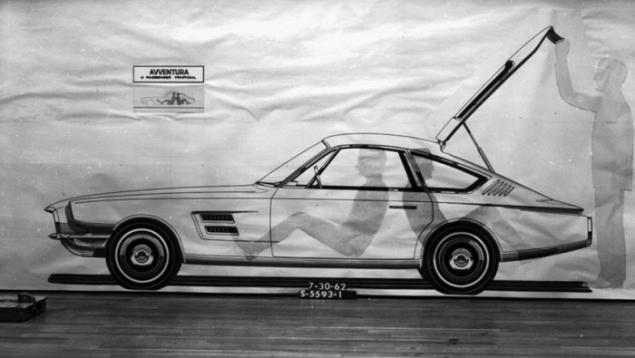
In parallel with the creation of the original designers Mustang Ford also saw a number of projects double - as a more affordable return to the roots Thunderbird, which by this time has become a much larger four-seater. The idea of double Mustang was the one to which designers are often returning to the period between the creation of concepts and 1 Mustang Mach III 1992. In addition to some track-oriented Mustang, in which the rear seats have been removed to save weight, Mustang ever produced in a strictly double version. < br />
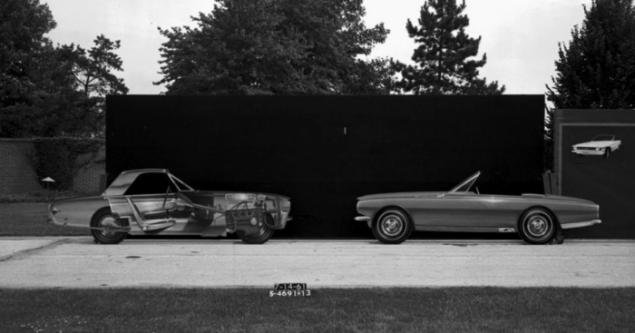
1962 Allegro Design Concept
In 1962, the project team, led by Jean Bordinatom worked on several iterations of design Allegro. While unreleased Mustang 1965 was a very different car, different almost every visual detail from Allegro, design development has spawned major proportions that define the appearance of most models of Mustang for the next five decades. Notchback had the same long hood and short body with a compact cabin that vehicles leaving the plant workshops Rouge two years later.
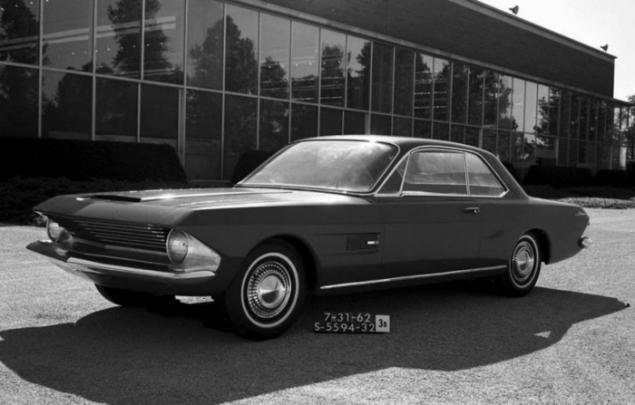
A mid-1963 Double Mustang Concept
Although she probably never seen as a production model Mustang, the hard-top variation concept Mustang 1 of 1962, really kind of served as a source of inspiration for the car GT40 MK I, which raced at Le Mans and other tracks from 1964.
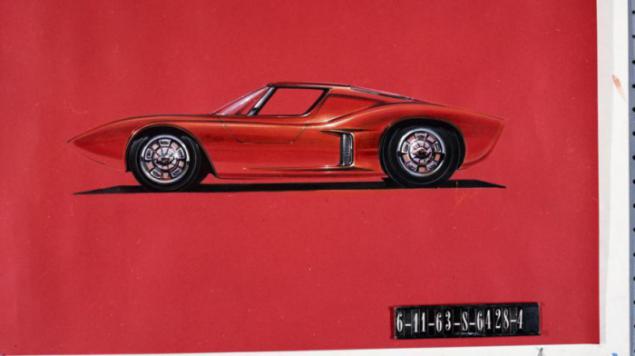
1964 Draft Double Mustang
This model variant double Mustang (1964) embodied some of the design signals a production car in 1965, including the characteristic side panels.

1965. Four Mustang sedan
Like today, in the 60 years of the twentieth century among the bosses of Ford were those who thought that if you have a product that is extremely successful, such as the Mustang, you must think about how to make this idea again and again. Fortunately for fans of the Mustang head cold in management Ford won and was not allowed to kill the image of the model.
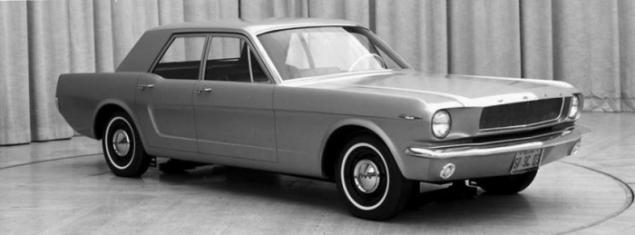
1966. Mustang Station Wagon - Mustang station wagon in
In the mid-'60s Ford designers were thinking at least on two different concepts Mustang wagon and created at least one working prototype based on the coupe in 1966. Other study design includes elements for the updated models that will appear later. All currently known versatile Mustang had three doors, making them much closer to the European car with a body shuting break, rather than the traditional American family station wagon.

In 1965, the head of the advertising agency J. Walter Thompson, in charge of ads Ford, - Barney Clark and designer Bob Kamberford hired Italian bodybuilder studio Intermeccanica to build a single station wagon model Mustang. In 1966, the result of their labors graced the cover of the October issue of Car and Driver. In the photo below - a replica of the work of Joe Kampa for sale by auction house RK Motors. To create it, he used the Ford Mustang in 1965. Camp cut and lengthened the roof to create a station wagon and fix the back door, got "factory" look.
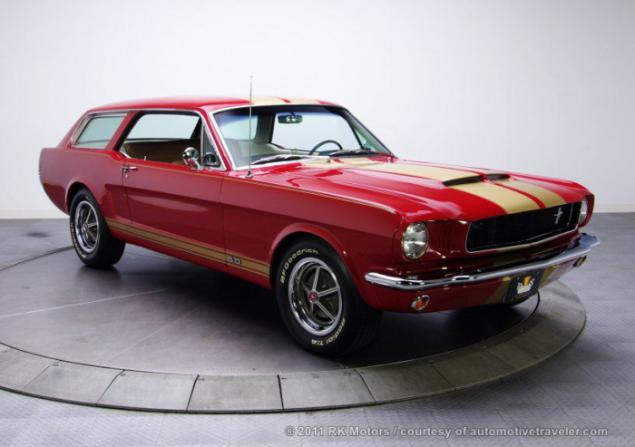
1967. Allegro II Concept
In 1967, Ford designers decided to play one of the original concepts Mustang 1962 in a new form. Taking the fastback Avanti / Allegro, they removed the windows, replacing it with the windshield with a deep cut in the style speedster, gave the concept of pillars at the back of racks and a new rear. The revised concept was named Allegro II.

1966. Mach I Concept
While the first generation Mustang moved from ponies to big cars and heavy oil to the engine Karama Big Block, the concept of the Mach 1 was established as a preliminary version of the model in 1968. The design of the original bow of the concept car inspired Mustang II in 1963.

1967. Mach II Concept
Mustang has set sales records after its launch in 1964, when Ford's chief designer Jean Bordinat and automotive group decided to try to play with the concept of Mach II. Engine 289 Hi-Po V8 was moved from the front of the seat to assess the suitability of mid-engine format as a possible successor to the Shelby Cobra. Despite the different arrangement of the engine, Mach II kept a long hood and short body proportions Mustang. Unfortunately, the concept of Mach II never traveled outside of the podium auto show.

1970. Mustang Milano Concept
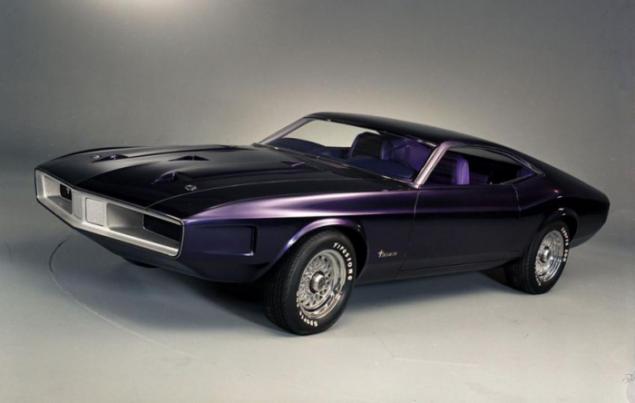
For the first time shown to the public in February 1970 at the Chicago Auto Show, a concept Mustang Milano showed nearly horizontal rear part of the body and a sharp, extended nose, which can later be seen in the production model in 1971. However, in addition to these two elements, Milano actually had little similarity with any serial Mustang. The car, which is probably the most heavily influenced silhouette Milano, was sold in the mid-1970s, Falcon-XB.

1980. Mustang RSX Concept
Created by the Italian design studio Ghia Concept RSX was conceived as a special rally car based on the new third-generation Mustang body with Fox, debuted in 1979 model year. On track one inch wider wheelbase and 5, 6 inches shorter than the "civil» Mustang, a model RSX had increased ground clearance that would need it to fight off-road rally stages of Europe.

1990. Bruce Jenner 'and Rambo
In 1990, Ford designers have considered a number of topics to replace long hold third-generation Mustang. The bodies of notchback and hatchback will be replaced by a single format fastback coupe. If the third-generation model has moved away from many of the original motives, the fourth returned items such as galloping pony in the grille, side panels with grooves and three-section taillights. The concept, known as "Bruce Jenner," considered aggressive enough to be named Mustang.
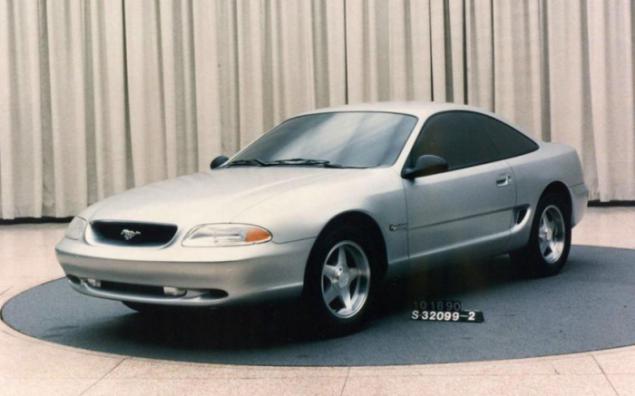
In turn, the alternative version appeared under the name "Rambo", seemed too extreme for serial production.

1992 Mach III Concept
Mach III Concept became the first public hint of the new direction in the design of the model, which is embodied in the fourth generation Mustang. The serial version was the classic grille with pony badge, side panels with grooves and three-section rear lights, but the front glazing with low-cut style speedster never went to series. In addition, this car was never released in a double version.
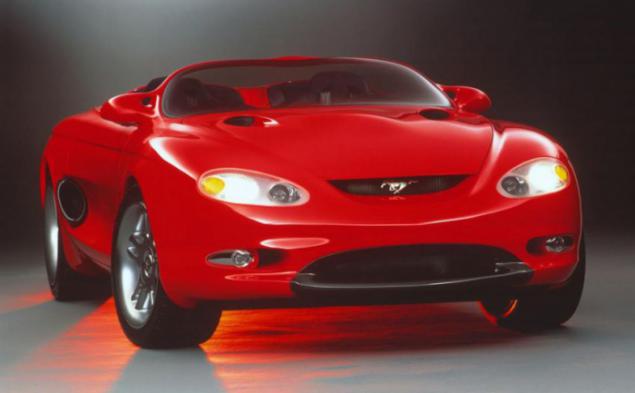
Wildest imagination of designers anticipated many of the modern trends in the automobile industry, where manufacturers seek to maximize "populate" all the niches and segments are designed in the same style cars. In his time at Ford did not agree. Is it good or not - judge for yourself.

1961 Avventura, Avanti, Allegro
When the project came Avventura from sketch to the physical model, the hatch was replaced on the boot lid, the rear seats are deployed in the traditional frontal orientation. Originally existed under the name Avanti concept was later the name Allegro - probably because Studebaker at the same time began to produce his compartment Avanti.

In parallel with the creation of the original designers Mustang Ford also saw a number of projects double - as a more affordable return to the roots Thunderbird, which by this time has become a much larger four-seater. The idea of double Mustang was the one to which designers are often returning to the period between the creation of concepts and 1 Mustang Mach III 1992. In addition to some track-oriented Mustang, in which the rear seats have been removed to save weight, Mustang ever produced in a strictly double version. < br />

1962 Allegro Design Concept
In 1962, the project team, led by Jean Bordinatom worked on several iterations of design Allegro. While unreleased Mustang 1965 was a very different car, different almost every visual detail from Allegro, design development has spawned major proportions that define the appearance of most models of Mustang for the next five decades. Notchback had the same long hood and short body with a compact cabin that vehicles leaving the plant workshops Rouge two years later.

A mid-1963 Double Mustang Concept
Although she probably never seen as a production model Mustang, the hard-top variation concept Mustang 1 of 1962, really kind of served as a source of inspiration for the car GT40 MK I, which raced at Le Mans and other tracks from 1964.

1964 Draft Double Mustang
This model variant double Mustang (1964) embodied some of the design signals a production car in 1965, including the characteristic side panels.

1965. Four Mustang sedan
Like today, in the 60 years of the twentieth century among the bosses of Ford were those who thought that if you have a product that is extremely successful, such as the Mustang, you must think about how to make this idea again and again. Fortunately for fans of the Mustang head cold in management Ford won and was not allowed to kill the image of the model.

1966. Mustang Station Wagon - Mustang station wagon in
In the mid-'60s Ford designers were thinking at least on two different concepts Mustang wagon and created at least one working prototype based on the coupe in 1966. Other study design includes elements for the updated models that will appear later. All currently known versatile Mustang had three doors, making them much closer to the European car with a body shuting break, rather than the traditional American family station wagon.

In 1965, the head of the advertising agency J. Walter Thompson, in charge of ads Ford, - Barney Clark and designer Bob Kamberford hired Italian bodybuilder studio Intermeccanica to build a single station wagon model Mustang. In 1966, the result of their labors graced the cover of the October issue of Car and Driver. In the photo below - a replica of the work of Joe Kampa for sale by auction house RK Motors. To create it, he used the Ford Mustang in 1965. Camp cut and lengthened the roof to create a station wagon and fix the back door, got "factory" look.

1967. Allegro II Concept
In 1967, Ford designers decided to play one of the original concepts Mustang 1962 in a new form. Taking the fastback Avanti / Allegro, they removed the windows, replacing it with the windshield with a deep cut in the style speedster, gave the concept of pillars at the back of racks and a new rear. The revised concept was named Allegro II.

1966. Mach I Concept
While the first generation Mustang moved from ponies to big cars and heavy oil to the engine Karama Big Block, the concept of the Mach 1 was established as a preliminary version of the model in 1968. The design of the original bow of the concept car inspired Mustang II in 1963.

1967. Mach II Concept
Mustang has set sales records after its launch in 1964, when Ford's chief designer Jean Bordinat and automotive group decided to try to play with the concept of Mach II. Engine 289 Hi-Po V8 was moved from the front of the seat to assess the suitability of mid-engine format as a possible successor to the Shelby Cobra. Despite the different arrangement of the engine, Mach II kept a long hood and short body proportions Mustang. Unfortunately, the concept of Mach II never traveled outside of the podium auto show.

1970. Mustang Milano Concept

For the first time shown to the public in February 1970 at the Chicago Auto Show, a concept Mustang Milano showed nearly horizontal rear part of the body and a sharp, extended nose, which can later be seen in the production model in 1971. However, in addition to these two elements, Milano actually had little similarity with any serial Mustang. The car, which is probably the most heavily influenced silhouette Milano, was sold in the mid-1970s, Falcon-XB.

1980. Mustang RSX Concept
Created by the Italian design studio Ghia Concept RSX was conceived as a special rally car based on the new third-generation Mustang body with Fox, debuted in 1979 model year. On track one inch wider wheelbase and 5, 6 inches shorter than the "civil» Mustang, a model RSX had increased ground clearance that would need it to fight off-road rally stages of Europe.

1990. Bruce Jenner 'and Rambo
In 1990, Ford designers have considered a number of topics to replace long hold third-generation Mustang. The bodies of notchback and hatchback will be replaced by a single format fastback coupe. If the third-generation model has moved away from many of the original motives, the fourth returned items such as galloping pony in the grille, side panels with grooves and three-section taillights. The concept, known as "Bruce Jenner," considered aggressive enough to be named Mustang.

In turn, the alternative version appeared under the name "Rambo", seemed too extreme for serial production.

1992 Mach III Concept
Mach III Concept became the first public hint of the new direction in the design of the model, which is embodied in the fourth generation Mustang. The serial version was the classic grille with pony badge, side panels with grooves and three-section rear lights, but the front glazing with low-cut style speedster never went to series. In addition, this car was never released in a double version.

Tags
See also
Cars of the future
Automotive News: bit of everything
Tom Ford 2013-2014
Soviet car industry - as a big haystack.
Ford «runs" into independent developers diagnostics
Most cine cars (10 photos)
Top premiere in Detroit in 2013 (Detroit Auto Show 2013)
A friend, comrade and brother
Cars on the streets of London
10-ka coolest kinotachek!

















